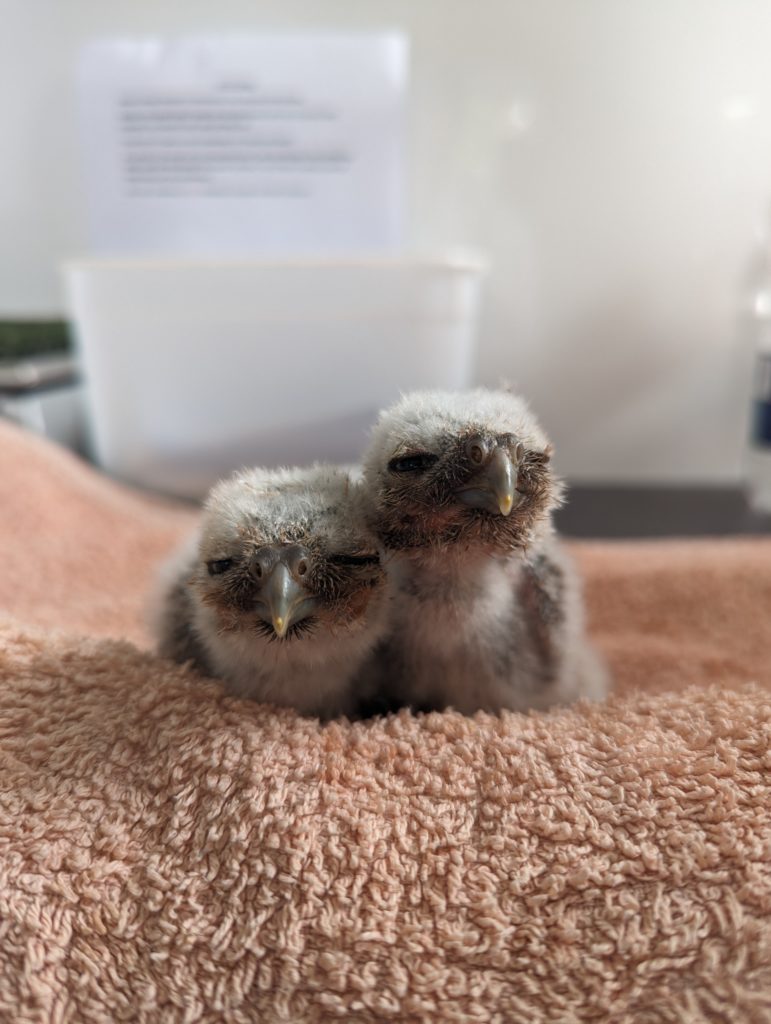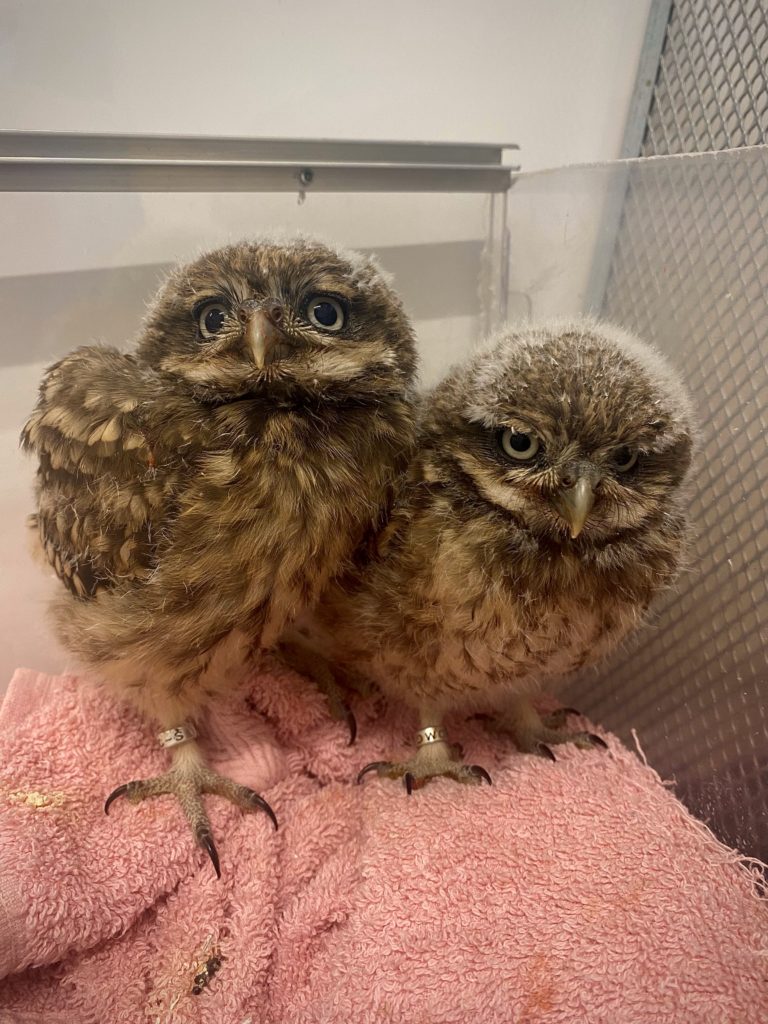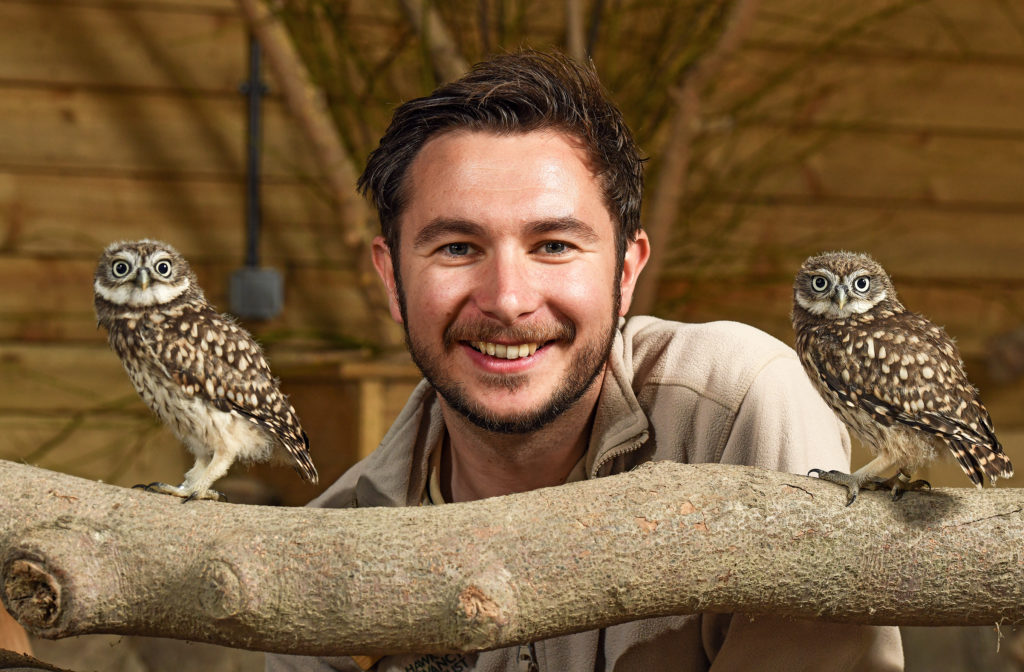
Last month, we shared the exciting news of our newest arrivals: Little Owls, Cheddar and Mozzarella. Since arriving in May, they are now almost fully grown, and their personalities are really starting to shine! We chatted to Deputy Head of Living Collection, Tom Morath, who has spent much of this past month working alongside this adorable pair, about what it’s like working with them both.

 “It’s always an exciting time when we welcome new birds to the Hawk Conservancy Trust and this is especially true when those birds are still just chicks. Over the last few weeks, I’ve had the great privilege of watching two Little Owl owlets change from tiny bundles of white down into fully grown youngsters.
“It’s always an exciting time when we welcome new birds to the Hawk Conservancy Trust and this is especially true when those birds are still just chicks. Over the last few weeks, I’ve had the great privilege of watching two Little Owl owlets change from tiny bundles of white down into fully grown youngsters.
We’ve raised young owls here before of course – many regular visitors will be familiar with birds like Sweeney Todd, our Snowy Owl, Wispa our Boobook Owl and Troy our Tawny Owl for example. Each of these birds have started out life here at the Trust, spending as much time with members of our team here as possible to ensure that, when they grow up, they feel as comfortable and confident around us as possible.
But these Little Owls, along with changes in our working protocols, presented us with a challenge. In order to limit the risk of diseases finding their way into the Trust, we have put in place more thorough processes for any new animals arriving here.
During their initial period, five members of the team started working with them in rotation – making sure that any potential cross contamination between these new owls was kept to minimum by wearing a white lab coat, shoe covers and gloves. We all felt like we were in an episode of Holby City! Luckily for me I was one of them! They needed feeding around the clock with the first being as early at 7am and the latest at around 9pm. It’s an opportunity to consider just how hard the parent birds would have to work in the wild – these Little Owls were regularly consuming one third of their own body weight in food. Imagine having three or even four mouths to feed around the clock. They need to eat so much food because of their fast growth rate – at 2 months they are practically fully grown and as I type this I can’t quite believe that the two owls in the aviary just outside are the same birds I welcomed here as fluff-balls just a few short weeks ago.
Watching them at the very start of their journey (they were just 60 grams when they first arrived here!) was a joy. In the first week they lived in heated accommodation in our Hospital Annex in an ice-cream tub together, surrounded by rolled up towels. At this time, they could only just about keep their eyes open to feed before they would, with a full belly, sleep off their breakfast, lunch, tea or supper. Over time they’ve become more active – graduating from their ice-cream tub to larger accommodation. In a matter of a couple of weeks they could thermoregulate (maintain their own body temperature) and start to explore the big wide world around them. They’ve recently moved into an aviary where you can come to say hello to them after being given a full routine health check by our specialist vet.

At about six weeks old they made their debut – starring in many of our Brilliant Bird Brains sessions. A talk we hold every day in the summer at the Trust, Brilliant Bird Brains offers us the opportunity to present a more intimate deep dive into how we work with one of our birds in particular. It’s usually an individual member of the team (or sometimes a group) that is undertaking a little extra training or could do with a small audience to help them prepare for being in displays. What better way to begin our Little Owl’s lives here as ambassadors for their species. Our Conservation and Research team focus some of their work with Little Owls. Dr Matt Stevens, our UK Conservation Biologist, has installed and monitors nest boxes for Little Owls across southern England. You can read more about this project here.
Over the course of the next few months I hope you can join us as we watch their journey to becoming fully fledged members of our flying team – every member of the Bird Team is excited to be working with them. You can expect to see them beginning to make appearances in the Woodland Owls display as soon as they’re ready – we hope before the end of the summer holidays.”
Photo: Ollie Thompson/Solent News & Photo Agency